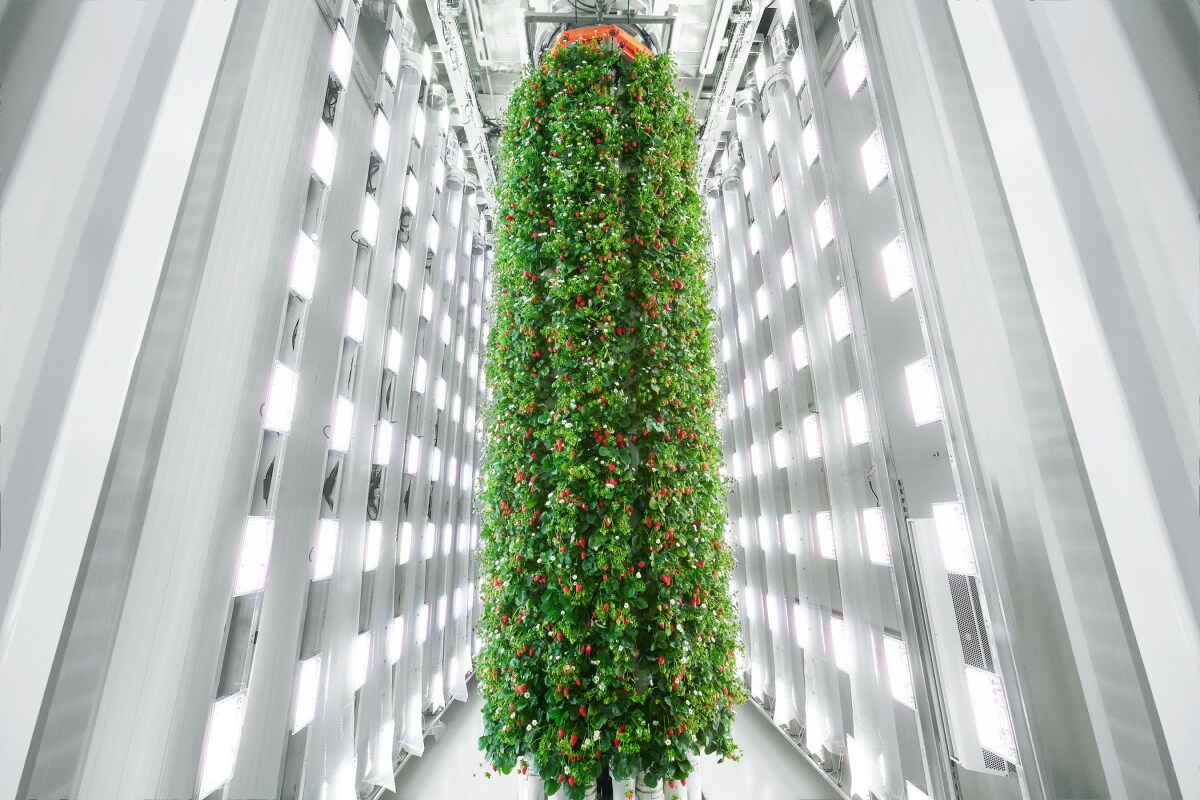
We are seeing revolutionary tech solutions to excellent organic food production. Of course we are seeing the low hanging fruit been adapted now ,but actually not much is needed. After all we have sweet potatoes hanging from vines while been continuously produced.
It is not everything yet, but pretty close.
All this does allow us to often avoid field production which is good. Those are better used to properly support animal husbandry.
'World-first' indoor vertical farm to produce 4M pounds of berries a year
September 25, 2024
Plenty's 30-ft vertical indoor towers of strawberries
Major steps towards better, sustainable and affordable food production free of environmental challenges have been taken, with the "world's first farm to grow indoor, vertically farmed berries at scale" opening in Richmond, VA. It's backed by an international team of scientists that see this new phase of agriculture as a way to ease global food demands.
The Plenty Richmond Farm is designed to produce more than four million pounds (1.8M kg) of strawberries grown indoors vertically in 30-ft-tall (9-m) towers, using up less than 40,000 square feet – or less than a single acre. This is a fraction of the land needed in traditional strawberry production, which is also subject to seasonal and environmental factors that limit yield.
The company says the strawberries, from global company Driscoll's, will be on grocery store shelves in early 2025.
“Plenty’s farm will boost local agriculture production and drive economic development, all while diversifying against risks and protecting the environment," said Virginia Governor Glenn Youngkin. "We look forward to supporting their innovative approaches to revolutionizing the industry.”
The grow room will be highly controlled to optimize pollination and fruit production
Plenty
To date, plant-based commercial vertical farming has mostly been limited to the production of lettuce crops, but this latest technological advancement has broadened the scope of what can be grown upwards. With temperature, light and humidity controlled across 12 growing 'rooms,' pollination of plants has also been engineered to be more efficient than bees. Ultimately, the company believes this will result in more uniformity in fruit and result in less waste.
“This farm is a model for the positive impact climate-agnostic agriculture can have, and proof that vertical farming can deliver the crop diversity, scaled and local production needed to future-proof the global food system,” said Arama Kukutai, Plenty CEO. “The Plenty Richmond Farm is the culmination of 200 research trials over the past six years to perfect growing strawberries with consistent peak-season flavor indoors year-round. Driscoll’s sets an incredibly high bar for the quality of its berries and we’re excited to join forces to consistently deliver an ultra-premium Driscoll’s strawberry year-round.”
This video, from a year ago, shows the company's early work in establishing the vertical-farming model that could enable this sort of small-area, high-yield and year-round production of food.
Plenty—Creating the Future of Farming in Compton
The opening of this first vertical farm is the culmination of years of scientific research into the model, with work undertaken by a global team from organizations including The University of Queensland, Macquarie University, Wageningen University, University of Florida, University of the Basque Country, CAS Center for Excellence in Molecular Plant Sciences and Shanghai Institute of Plant Physiology and Ecology.
“Vertical farms grow crops indoors in stacked layers and provide consistent yield and crop quality but they use a tremendous amount of costly energy for light and air flow,” said Paul Gauthier, Professor of Protected Cropping at the University of Queensland, Australia. “If we create a more dynamic environment that turns lights and sensors on and off during the day in line with the cycles of photosynthesis rather than leaving them on all the time, we could tap into cheaper energy at off peak times and still maximize the advantages of vertical farming.
“I managed to get strawberries to produce 6 kg (13 lb) per plant when everybody was saying that the maximum you could produce in a greenhouse was 2 kg (4.4 lb)," he added. “I multiplied the strawberry yield by three by modifying the environment and pushing them to the limit."
The Richmond farm uses 97% less land and up to 90% less water than conventional farming, eradicates the use of pesticides, and the controlled environment and shorter supply chain will also lower pathogenic risk to crops.
“I would like to see protected cropping or controlled environment agriculture treated as a separate discipline of plant science," added Gauthier. “If we are to increase food production by as much as 70% by 2050, we need to look at things differently.
"That is what vertical farming allows us to do – we didn’t have this possibility before," he added.
"By combining our 100 years of farming expertise and proprietary varieties along with Plenty’s cutting-edge technology, we can deliver the same consistent flavor and quality our customers love – now grown locally," said Soren Bjorn, Driscoll’s CEO. “This new innovative farm is a powerful step forward in continuing to drive category growth in new ways for our customers and consumers.”
<iframe width="800" height="450" src="https://www.youtube.com/embed/clDlTVwWZ1I" title="Plenty—Creating the Future of Farming in Compton" frameborder="0" allow="accelerometer; autoplay; clipboard-write; encrypted-media; gyroscope; picture-in-picture; web-share" referrerpolicy="strict-origin-when-cross-origin" allowfullscreen></iframe>
No comments:
Post a Comment